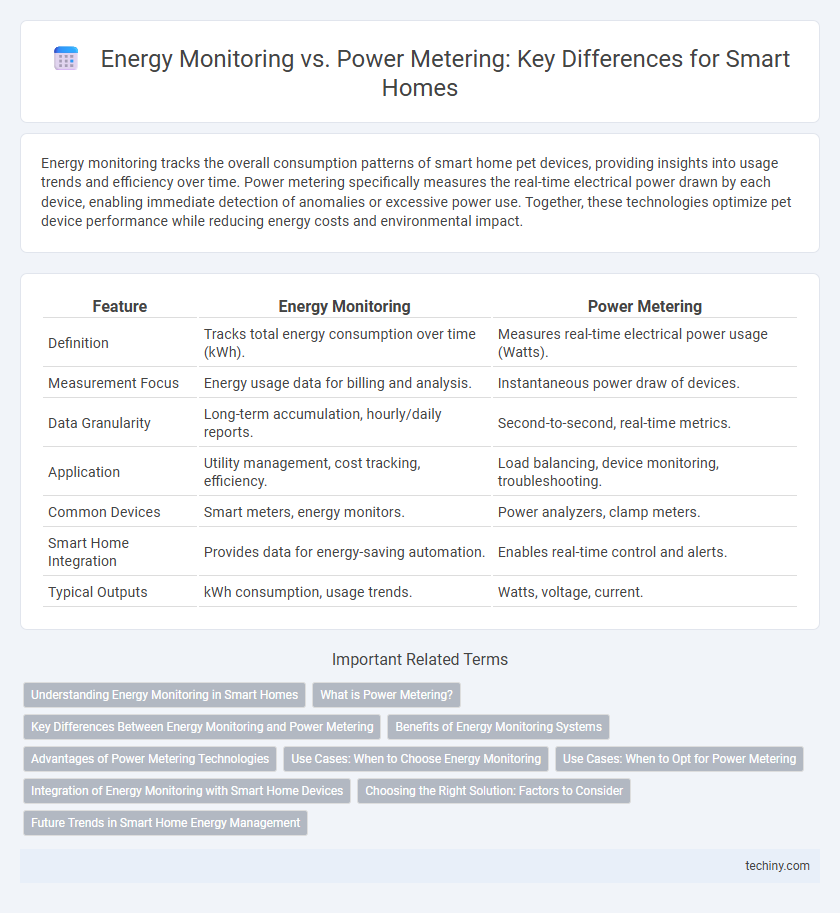Energy monitoring tracks the overall consumption patterns of smart home pet devices, providing insights into usage trends and efficiency over time. Power metering specifically measures the real-time electrical power drawn by each device, enabling immediate detection of anomalies or excessive power use. Together, these technologies optimize pet device performance while reducing energy costs and environmental impact.
Table of Comparison
| Feature | Energy Monitoring | Power Metering |
|---|---|---|
| Definition | Tracks total energy consumption over time (kWh). | Measures real-time electrical power usage (Watts). |
| Measurement Focus | Energy usage data for billing and analysis. | Instantaneous power draw of devices. |
| Data Granularity | Long-term accumulation, hourly/daily reports. | Second-to-second, real-time metrics. |
| Application | Utility management, cost tracking, efficiency. | Load balancing, device monitoring, troubleshooting. |
| Common Devices | Smart meters, energy monitors. | Power analyzers, clamp meters. |
| Smart Home Integration | Provides data for energy-saving automation. | Enables real-time control and alerts. |
| Typical Outputs | kWh consumption, usage trends. | Watts, voltage, current. |
Understanding Energy Monitoring in Smart Homes
Energy monitoring in smart homes provides real-time insights into electricity consumption, enabling homeowners to track usage patterns and optimize energy efficiency effectively. Unlike basic power metering that measures instantaneous power draw, energy monitoring systems analyze cumulative energy usage over periods, offering detailed reports and alerts for abnormal consumption. Integrating smart energy monitors with automation systems helps reduce waste, lower utility bills, and supports sustainability goals through informed decision-making.
What is Power Metering?
Power metering refers to the precise measurement of electrical power consumption in real-time, enabling smart home systems to track energy usage at the device or household level. This technology collects data on voltage, current, and power factor to provide accurate insights into how energy is being consumed. Power metering is essential for optimizing energy efficiency, reducing costs, and supporting automated control in smart homes.
Key Differences Between Energy Monitoring and Power Metering
Energy monitoring tracks the total energy consumption over time, measured in kilowatt-hours (kWh), providing insights into overall usage patterns and efficiency. Power metering measures real-time electrical power in watts (W), allowing for instant assessment of load demand and consumption spikes. The key difference lies in energy monitoring's cumulative data for billing and optimization versus power metering's focus on instantaneous power flow for immediate control and troubleshooting in smart homes.
Benefits of Energy Monitoring Systems
Energy monitoring systems provide real-time insights into overall household energy consumption, enabling users to identify high-usage appliances and reduce waste efficiently. Unlike basic power metering, these systems offer detailed analytics and customizable alerts that promote proactive energy management and cost savings. Integration with smart home devices enhances automation and supports sustainable living through smarter energy consumption patterns.
Advantages of Power Metering Technologies
Power metering technologies offer precise real-time tracking of electricity consumption, enabling homeowners to identify high-usage devices and manage energy more efficiently. Advanced power meters provide granular data, supporting automation systems and facilitating cost savings through demand response strategies. Integration with smart home ecosystems enhances control, improves energy transparency, and contributes to sustainable energy use.
Use Cases: When to Choose Energy Monitoring
Energy monitoring is ideal for homeowners seeking comprehensive insights into total energy consumption patterns, enabling optimized usage and cost savings over time. It tracks cumulative energy usage, making it suitable for budgeting, identifying energy-hungry appliances, and improving overall efficiency. Power metering is more appropriate for real-time power flow measurement, but energy monitoring excels in long-term analysis and strategic energy management in smart homes.
Use Cases: When to Opt for Power Metering
Power metering is ideal for real-time tracking of electrical consumption in specific appliances or circuits within a smart home, enabling precise energy cost allocation and identification of energy-intensive devices. Use cases include monitoring high-power equipment like HVAC systems or electric vehicle chargers to prevent overloads and optimize usage patterns. Opting for power metering supports targeted energy efficiency improvements and ensures safety through detailed load analysis.
Integration of Energy Monitoring with Smart Home Devices
Energy monitoring in smart homes provides comprehensive insights by tracking overall energy consumption patterns, while power metering measures real-time electrical usage of individual devices. Integration of energy monitoring systems with smart home devices enables automated energy management, optimizing efficiency through intelligent scheduling and remote control. This synergy reduces energy waste and lowers utility costs by leveraging data analytics and real-time feedback from connected appliances.
Choosing the Right Solution: Factors to Consider
Selecting the right energy monitoring or power metering solution for a smart home depends on accuracy requirements, real-time data availability, and integration capabilities with existing devices. Energy monitoring systems offer comprehensive usage patterns for optimizing energy consumption, while power meters provide precise measurements of electrical parameters for specific appliances. Consider factors such as scalability, cost, user interface, and compatibility with home automation platforms to ensure efficient and actionable energy management.
Future Trends in Smart Home Energy Management
Energy monitoring in smart homes evolves beyond basic power metering by integrating real-time data analytics and AI-driven insights to optimize energy consumption patterns. Advanced systems forecast energy needs, enhance renewable integration, and empower users with tailored recommendations for sustainable living. Future trends emphasize seamless interoperability with smart grids and demand response programs, driving efficiency and cost savings in residential energy management.
Energy Monitoring vs Power Metering Infographic

 techiny.com
techiny.com